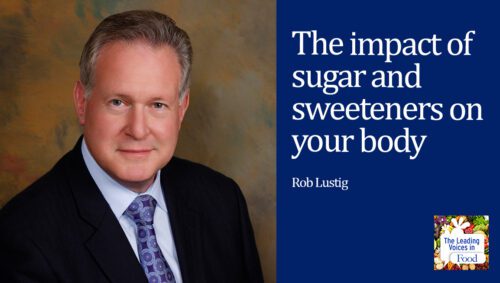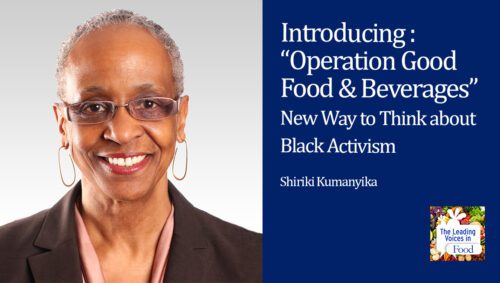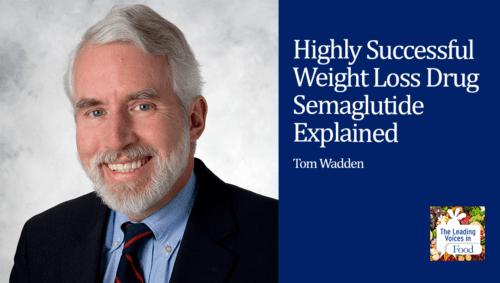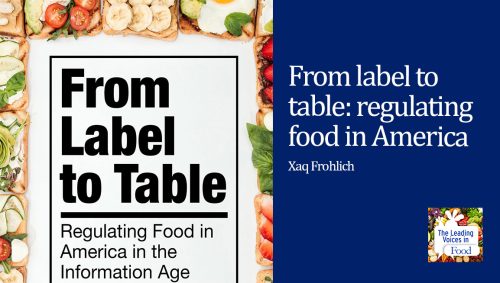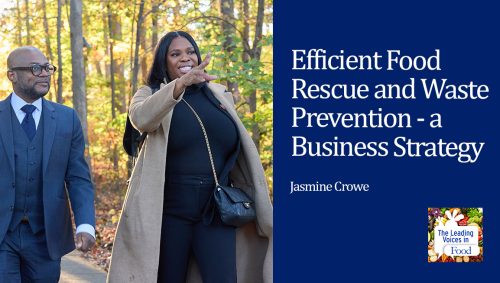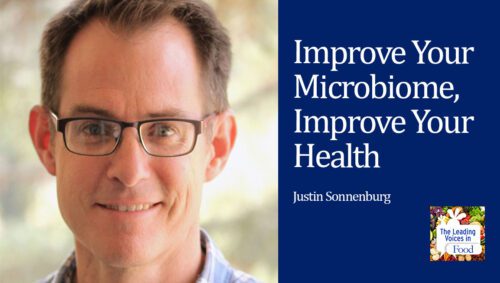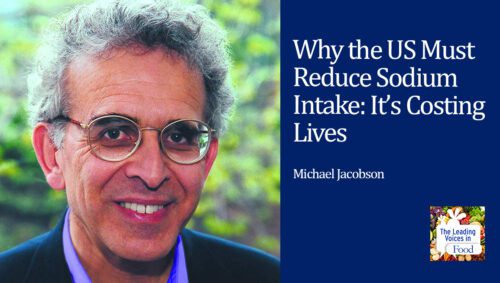The Leading Voices in Food
E159: Ultra-processed Foods Have Addiction Impact on our Bodies
Much has been written and said about ultra-processed foods, first in scientific circles and now more broadly in the media. This concept is relatively new, but what is even newer in this discussion is how such foods figure into the issue of food and addiction. Our guest, Dr. Ashley Gearhardt is doing pioneering work on this. So, we eat a lot of these foods. A paper published several months ago, found that as much as 80% of all calories consumed in the US and in Canada come from such foods. Such diets are high in added sugar, in fat and saturated fat and low in fiber and key vitamins and minerals. We’ve recorded earlier podcasts on ultra-processed foods, most notably with Dr. Carlos Monteiro, who created the term. But now let’s talk addiction. Ashley Gearhardt is Associate Professor in the department of psychology at the University of Michigan and as a leading expert on the issue of food and addiction.
Subscribe: Apple Podcasts | TuneIN | Google Podcasts | SoundCloud | PocketCasts | Radio Public
Tags: Addiction & Food | Food Safety & Food Defense | Ultra-processed Food & Additives |

Ashley Gearhardt, Ph.D., is an Associate Professor of Psychology in the Clinical Science area at the University of Michigan. She also earned her B.A. in psychology from The University of Michigan as an undergraduate. While working on her doctorate in clinical psychology at Yale University, Dr. Gearhardt became interested in the possibility that certain foods may be capable of triggering an addictive process. To explore this further, she developed the Yale Food Addiction Scale (YFAS) to operationalize addictive eating behaviors, which has been linked with more frequent binge eating episodes, an increased prevalence of obesity and patterns of neural activation implicated in other addictive behaviors. It has been cited over 800 times and translated into over ten foreign languages. Her areas of research also include investigating how food advertising activates reward systems to drive eating behavior and the development of food preferences and eating patterns in infants. She has published over 100 academic publications and her research has been featured on media outlets, such as ABC News, Good Morning America, the Today Show, the Wall Street Journal, and NPR.
Interview Summary
So, let’s start by you telling us what is ultra-processed food?
Well, I’ll start with the scientific definition which is foods composed of mostly cheap industrial sources of dietary energy and nutrients plus additives. But in layman’s term, I think the easiest way to have a feel for what ultra-processed foods are, they’re the sorts of baked goods and sugary treats and salty snacks that are on our shelves. That when you look at the ingredient list, you kind of can’t pronounce or understand many of the ingredients in that food substance. That’s a big way for me that I tell that something’s ultra-processed.
You’ve made very interesting parallels between these ultra-processed foods and cigarettes. Can you explain that?
Yes, absolutely. So, with cigarettes, one of the things that’s really surprised me is that we know nicotine is the addictive agent in cigarettes. But I think something that surprised me recently is we’re all probably consuming nicotine every single week. Nicotine is in things like tomatoes and eggplants. But of course, we’re not getting hooked on eggplants and tomatoes and consuming them to excess. It was really when Big Tobacco got involved and they were able to take the tobacco leaf which has high levels of nicotine and process and optimize it so that it gave us naturally extreme levels of nicotine that were absorbed really rapidly into the system. And they did that through manipulating the nicotine leaf, but also putting additives in there. Things like bronchodilators that let the smoke to get into the lung more rapidly and to hit the brain. And they added all these different flavors and tastes with sugar and cocoa being the most popular. So, really industry got in and ultra-processed the tobacco leaf that led it to be the perfect delivery device for nicotine in a way that made it addictive.
And I think about the same thing with our foods. When I think of naturally occurring foods that have sugars and fats that we enjoy, we find reinforcing, like berries and nuts, people just don’t seem to develop a compulsive relationship with those foods. It’s really when industrial processes get involved and it amps up the level of that reinforcing ingredients of the sugar sugars and the fats, but then it also ultra-processes it into these packages that just delivers it so rapidly into our body and into our brain, and adds all these unique flavorants and additives that further amplify the rewarding nature of things like sugar and fat. So, the way the companies are manufacturing the foods then makes them maximally palatable, but then they interact with the brain in interesting ways too.
So, how would you know if these ultra-processed foods are addictive?
I think one of the things that’s a misunderstanding at times about addiction is that there’s some sort of magical brain signature that if the brain just does this, we know something’s addictive. And that is not the case. Scientifically, we haven’t figured out what that would be. What we’ve done to figure out whether something’s addictive or not is really to look mostly at the behaviors of the people who are consuming it. And so again, going back to cigarettes. What really led people to consider these substances as not just a bad habit, but truly addictive, was how compulsively people were consuming them. You know, that people wanted to quit desperately and they couldn’t, even in the face of some really stark negative consequences like a lung cancer or emphysema. People come out of the hospital wanting to stop smoking and then start smoking right away. And we know as well that these substances impact our mood and our pleasure experiences. They’ll often help us feel a little less stressed, help us feel more pleasure. And we’ll work hard to get them and we enjoy them. If we know that doing a certain behavior will get us something like an addictive drug, we’re willing to do it over and over again.
And that was really, when we looked at cigarettes, the three core criteria that we used to decide that cigarettes were addictive in the Surgeon General’s report. They trigger compulsive behavior, they were really pleasurable and reduced negative feelings and they were reinforcing. Meaning they left us coming back for more.
And when I look at these ultra-processed foods, it’s clear to me that they meet all of those behavioral signatures. That people want to cut down and they can’t. Even in the face of something like having bariatric surgery and having your stomach fully rewired, about 30% of people are regaining the weight within a couple years. And they report that the cravings for these sorts of foods is one of the biggest obstacles. It’s these ultra-processed foods. They are impactful in giving us a hit of pleasure and helping us feel a little less bored and a little less stressed. Those are some of our major motivations for using them. And they’re very reinforcing. When we look at animal models, ultra-processed foods and the ingredients in those foods are arguably as reinforcing – meaning animals will work for them as much as they would for something like cocaine and definitely more than nicotine.
So, all of those factors together really strike me as fitting the bill for something that is addictive. And then when we bring the brain into it, we’re starting to understand from looking at the dopamine system which is kind of the core system that gets activated by addictive drugs, the degree to which fats and sugars – which are elevated in these ultra-processed foods – can cause the dopamine system to release. It’s actually a pretty similar magnitude to what alcohol and nicotine can do. So, all of these factors combined really lead us to see some really strong parallels, which to me, makes the case that these unique, novel, highly-processed substances should be considered addictive.
What you’re saying is very persuasive and another issue that’s come up in the context of drug addiction is tolerance. That people might need more of the drug over time in order to get the same reward. Is there any evidence of that in the context of food?
You know, it’s been really hard to study in humans, because unlike other drugs of abuse, we’re getting exposed to these sorts of foods from the time we’re one or two years old. So, if I try and look at even a teenager, I don’t have like that baseline to say, oh, this is how they used to respond to it and now they respond to it differently 18 years later. So, we’ve really kind of had to look at our animal models to help us get some information about tolerance. And in the animal models, we do see that exposure to the ultra-processed foods and the ingredients that are so heightened in these foods like sugar and fats cause changes in the reward system of the brain that is consistent with tolerance. I mean, look at those animals, they start binging on more and more and more of those foods over time, which also suggests they’re becoming tolerant to the effects. To me, I see some parallels in what we see in our society. Just looking at the fact that our portion sizes are getting bigger and bigger and bigger, and the amount of sugar is going up and up and up and salt is going up and up and up, suggests that the same amount of food or the same amount of sugar, just isn’t quite doing it for us. So, then we’re amping it up and taking something a little sweeter or eating more of it to get the fix that we would’ve had previously.
Well, it would be interesting, wouldn’t it, to take those animal intake curves that show increasing consumption of the rewarding foods and project from that what human weight trends would look like over time and then see how closely those lines parallel each other. I bet they’d be pretty close.
I bet they would as well.
And you know industry says, in defense of things like large portion sizes, that ‘we’re just giving consumers what they want.’ And other critics say, ‘heck no, you’re driving that consumers are eating so much by increasing portion sizes.’ It’s quite possible both are true and both could be being driven by this common effect on the brain of these highly reinforcing foods.
Absolutely. You know, we have a sense that the ultra-processed foods, in addition to being really tempting and rewarding and really activating your drive for wanting more and the industry will say that, they’re trying to create foods that have maximum craveability that inspire more-ishness, that you want more and more and more. I mean, these are all code words for addiction without saying it, but then they also seem to not be as effective at triggering our satiety signals. So, the food itself and the way that they’re engineered, leads us to want more and more and more and to not have those signals that it’s time to stop because we’re feeling full.
So, how do these foods make trusting our intuitions about what we’re eating more challenging?
The intuitive eating movement, I think has a lot of really wonderful things about it, of kind of connecting with yourself more. However, my one concern about it is that if you’re trying to intuitively eat ultra-processed foods, it’s not an even playing field. They trick your brain into wanting more. They’re not signaling hunger and satiety signals in the way that normal, minimally processed foods do. And we see in my lab that it’s really, really hard to distinguish when you’re hungry, because you need calories, and when you’re hungry, because you’re tempted by reward. I have this simulated fast food restaurant lab and we’ll bring people in, we’ll kind of randomize people. And say, half of them will go into this kind of normal blank lab space and we’ll ask them how hungry are you and ‘meh, not that hungry.’ And we’ll randomize these other group of people to come into our fast food restaurant lab where it smells like French fries and there’s all the cues of the restaurant and everything is kind of setting you up. And they’ll say, ‘oh, I’m really, really hungry.’ And the only thing that changed is that that one group is in that acute environment. So, their reward systems are kind of perked up and it’s hard to distinguish that fact that you’re now desiring food from I’m actually calorically deprived and I need calories. So, I think we have a hard time as humans, knowing when we’re truly hungry and when we’re being tempted by ultra-processed foods.
Over the course of human evolution, body weights have been pretty healthy for populations, for the most part. And that’s been true for century after century. Then all of a sudden in a very short period of time, body weight in basically all other countries has really skyrocketed. And it’s pretty hard to argue that people have changed in some fundamental way or that biology has changed in fundamental ways. What really seems to have changed are the food and physical activity environment, and you’re narrowing down exactly how those changes have been made and how ordinary biology that works well under normal circumstances, fails under abnormal circumstances and that’s how we’re living today.
Absolutely correct. And I think one thing that people sometimes don’t understand is that drugs of abuse, addictive drugs, they are hijacking the system that was designed so we would be seeking out food and calories and making sure we were eating enough. And those drugs of abuse are so novel and potent that they can get in and take that system and start to shift the drive towards those drugs rather than things like food and sustenance and things we need for survival. Now, these ultra-processed foods that are novel, chemical substances that really just popped up since the 70s and 80s, really, they are working on that same reward sustenance system and they’re on overdrive. So, they don’t even have to hijack this system. They just have to amp it up higher than it typically is by normal foods to start to trigger this loss of control, this compulsive seeking, this hard time stopping yourself even when you know it’s not good for you.
And what’s really interesting to me about the timeline, if we kind of say, it’s 70s, 80s, 90s, this is this time where we really feel like the food environment changed so drastically, that’s also when big tobacco really got into food. Philip Morris and R.J Reynolds were the biggest producers of the sort of processed foods that we’re talking about today, in the 80s. And they really used the same playbook, the same scientific strategies. Their know about how to develop and market and create these addictive substances like cigarettes to make them so optimized and apply that to the development of their food portfolios.
So, when we talk about ultra-processed foods, I think of them in my mind, much more as a similar substance to something like a cigarette, than an apple, or a salmon filet, because the process that creates them and the consequences for our brain and our psyche and our biology is much more similar to that cigarette than it is for those other sorts of foods, even though they all give us calories.
So, what do we know about how these ultra-processed foods affect children and adolescents?
To me, that’s one of the most concerning spots about this. And I would say that research is really just beginning. We know that that is the dominant source of calories for adolescents and children, when we are looking at the United States, that ultra-processed foods is where they’re getting most of their caloric intake. And our lab, we assess this addictive profile, the like classic signs of addiction with eating and we do that with these ultra-processed foods, and we do that in adults. And the current estimates is that about, anywhere between 15% to 20% of adults in the United States would meet this kind of diagnostic level of addiction to these ultra-processed foods.
What’s concerning is that we see about 15% of children and adolescents are showing that same addictive profile. Our research finds that this is a profile that’s associated with a harder time maintaining a healthy body weight, failure to respond to typical treatments, to help reduce obesity that it’s associated with mental health concerns like depression and difficulties with inhibitory control. Seeing this in kids and teens, in many ways is not surprising, because you’re not exposed to things like alcohol and cigarettes from the time you’re one to two years old. Whereas in contrast with children, by the time a kid is two years old, a major part of their diet are ultra-processed foods. And we really don’t know. We’re in the middle of the experiment to understand how does that impact a developing brain that would be more vulnerable to addictive substances and how does that set them up for a lifetime of struggling to maintain a healthy relationship with food?
Again, the animal models are very concerning. The animal models suggest that young, early exposure to those sorts of ingredients in ultra-processed foods and ultra-processed foods is particularly likely to change the brain and adolescent and young rats in a way that makes them vulnerable, not only to show an addictive profile with a those foods, but also to be more sensitized to the addictive properties of things like stimulants and alcohol. So, it is not an issue that might just be in the realm of food, but might also be setting people up to be vulnerable for other addictive substances as they get more exposure to them in adolescence and early adulthood.
Now, what you’re talking about is really concerning, especially in light of how much marketing of these ultra-processed foods goes on that’s directed at children and adolescents, and almost all of it is for the least healthy foods in the company’s portfolios. So, you think about kids getting bombarded by these inducements to eat these things, they’re engineered to taste really good and their biology starts getting hijacked at an earlier age such that tolerance may develop and they need more of the foods over time, it’s really pretty bad.
Yes. And you know, we’ve even done some work around withdrawal where I think people often think of withdrawal as really physical, with people like shaking or vomiting or sweating. That actually isn’t often how withdrawal from addictive drugs presents. It’s often, if you think of cigarettes more psychological. It is irritability and depression and kind of agitation. So, we’ve been looking at that in adults, what happens when people are trying to get off these foods and eat a healthier diet and people are reporting those same clusters of symptoms that we see with withdrawal from other addictive substances and it follows kind of the same time course, that it often starts in about 24 hours, it peaks in that first week where it’s really severe and hard and then slowly starts to taper off. And the more withdrawal people are experiencing, the more likely they are to fail at their weight loss attempt.
Now, when we started to do this work, we thought, well, wait, this wouldn’t just be happening with adults, we would expect this with children too if this is playing a role. So, we asked parents who had tried to cut their kids junk food down in the past year and asked them about the signs of withdrawal and they reported that, yes, their children had that experience, it followed the same time course as typical withdrawal syndromes and that children whose parents had addictive eating themselves were more likely to experience withdrawal. So, I just think for parents how challenging that is if you’re trying to help your child and maybe help yourself simultaneously move away from these ultra-processed foods, that if it’s triggering this aversive withdrawal syndrome that makes your child far harder to parent and while you’re also feeling that way, it really sets people up to fail.
So, let me ask you one final question. How do we reduce the harm that’s associated with these ultra-processed foods?
You know, I think if there’s one lesson we’ve learned from addiction over and over again, is that while we need to have good treatments and we need to provide people with psychoeducation, if we don’t address the environment, our treatments aren’t powerful enough to overcome that. So, again, cigarettes is our best example. We knew so much and we were developing nicotine gum and we had treatments out there that were available, but what really helped us turn back the tide was by addressing the environment around cigarettes through policy, by things like restricting marketing and taxation and restricting vending machines that children could so easily access. So, I fundamentally believe that for this same change to take place in the context of the harms of these foods, it’s going to have to take policy initiatives that focus on giving us an environment that allows us to have a fighting chance. And it’s even more relevant in the context of food because you don’t get to opt out of eating. So, you have to go into the grocery store that’s dominated by ultra-processed foods. My students here in college, they have to go into the dining hall that’s dominated by ultra-processed foods and that environment that’s so dominated by that, I think really works with our biology in ways that really mimics what we see with addictive substances that makes it hard for us to eat in a healthy, nourishing way.

